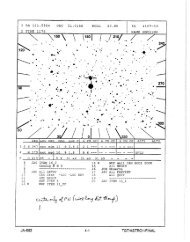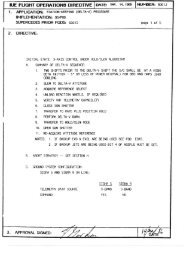The FUSE Archival Data Handbook - MAST - STScI
The FUSE Archival Data Handbook - MAST - STScI
The FUSE Archival Data Handbook - MAST - STScI
You also want an ePaper? Increase the reach of your titles
YUMPU automatically turns print PDFs into web optimized ePapers that Google loves.
4.1.2 File Name Conventions and Useful Program IDs<br />
All <strong>FUSE</strong> file names are composed of several identifying elements, but not all files contain each<br />
one of these elements. However, all exposure-level file names have the form {pppp}{tt}{oo}{eee}<br />
and begin with the following four elements:<br />
1. A four-digit program ID searchable in <strong>MAST</strong> (pppp: a letter plus a three-digit number;<br />
see Tables 4.2, 4.3 & 4.4).<br />
2. A target number (1–99), which identifies the target within the program (tt).<br />
3. An observation number (1–99) which specifies an observing sequence on the target (oo).<br />
Note that a target might have multiple observation numbers if multiple visits at different<br />
times and under different observing conditions were required.<br />
4. An exposure number (1–999) within the given observation (eee).<br />
An example of an exposure-level file name is D0640301004. Note that observation-level files<br />
have eee = 000.<br />
<strong>FUSE</strong> program ID codes convey general information about the category of the program, be<br />
it primarily for science or calibration. As indicated in Tables 4.2, 4.3 and 4.4, the dividing line<br />
is not hard. Sometimes useful science data can be extracted from data that were obtained for<br />
calibration purposes (for example, the flux calibration programs). Other times, the requirements<br />
of the calibration activity itself may seriously compromise the use of any spectral data for<br />
science. For some ‘I’ programs (in-orbit checkout), the data may be useful for science but only<br />
with great caution since the instrument may not have reached its final science configuration<br />
and focus yet. Many targets observed during in-orbit checkout were re-observed later in the<br />
mission, and the user should be wary of the IOC observation. However, these data are archived<br />
at <strong>MAST</strong>, so the user should be cognizant. Information on the sequence of instrument focus<br />
activities during in-orbit checkout can be found in the Instrument <strong>Handbook</strong> (2009); this may<br />
assist the user in evaluating the utility of the IOC observations.<br />
20




